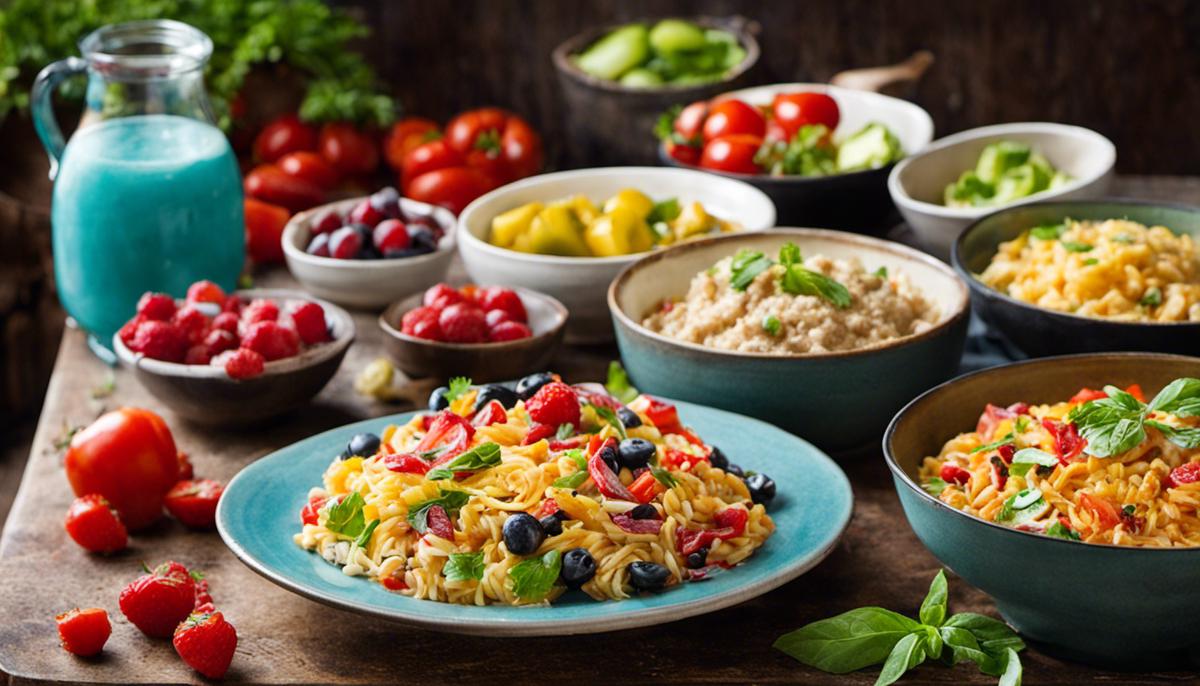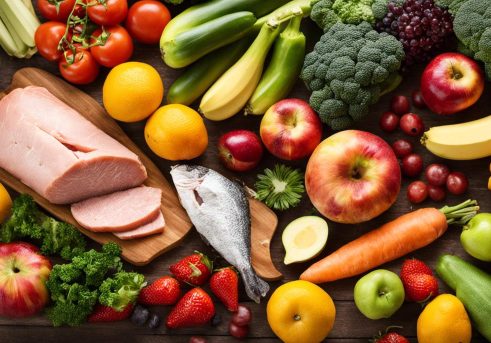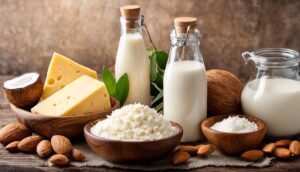In our journey towards a healthier lifestyle, the food we eat plays an integral part. The importance of adopting a diet with lower fat content cannot be understated, not just for weight loss, but for overall health and well-being. This article will delve into the concept of low-fat foods, their benefits, and common examples. It will also guide you through various low-fat cooking techniques that can make your culinary ventures healthier without compromising on taste. We’ll dive into ways to substitute high-fat ingredients in conventional recipes with lower-fat ones, concocting a health-conscious cuisine that’s as delectable as it is nourishing. Finally, the article will debunk the myth that healthy eating is monotonous and offer a plethora of low-fat recipes to inspire your kitchen creativity.
Understanding Low-Fat Foods
At the heart of every culinary adventure, there’s an ever-present drive to balance taste and health. With the growing health awareness and wellness trends, one term making frequent rounds is ‘low-fat’. But is there more to these low-fat foods than meets the eye? Absolutely! Shedding light on this subject, let’s delve into the intricate world of low-fat foods and their true essence.
Primarily, foods labeled as ‘low-fat’ often have their natural fat content removed or reduced during the processing stage. Traditionally, fats have borne the brunt of accusations for weight gain, heart diseases, and countless health conditions, pushing many to opt for low-fat dietary alternatives. That said, understanding fats and their role in our bodies forms a crucial base.
Fats play a significant role in delivering essential vitamins, providing energy, helping absorb certain nutrients, and maintaining body temperature, among other things. Not all fats are created equal. Unhealthy fats like trans fats and saturated fats often contribute to health problems, while healthy fats like mono and polyunsaturated fats can boost heart and brain health. Overall, moderation is the key, retaining the importance of fat in any diet.
The concept of ‘low-fat’ in the food industry primarily revolves around removing or reducing these unhealthy fats. However, a common misconception is that low-fat foods are inherently healthier. While they may contain less fat, it’s important to note that they are often laden with added sugars, salt, and artificial additives to compensate for the lost flavor and texture that fat naturally provides.
This means that while you’re cutting down fat intake, you could inadvertently be increasing your sugar, sodium, or artificial additives consumption. Take a ‘low-fat’ cookie, for instance. It may have less fat but could contain more sugar than its regular counterpart, negating the intended health benefits.
A useful tip for anyone exploring low-fat foods: always read the ingredient list and nutritional information. It’s a quick way to track what’s truly inside your food and avoids the pitfalls of cunning marketing gimmicks. Remember, the aim of adopting low-fat food isn’t merely about reducing fat intake but promoting an overall healthier diet.
Embracing a healthier diet doesn’t necessarily equate to depriving oneself of all the fatty goodness. Swap out unhealthy fats with healthier alternatives instead. Think olive oil instead of butter, or avocados as a substitute for mayonnaise in sandwiches. It’s not about eliminating – it’s about innovating!
In essence, the low-fat movement is far more than a mere dietary trend. It’s a deep dive into understanding our food’s composition, the role of fats, and how to make more informed food choices. Low-fat foods can undoubtedly be a healthful addition to diets, provided one navigates the landscape with knowledge and intent. Because at the end of the day, food isn’t just fuel – it’s a hearty celebration of flavors, experimentation, and yes, occasionally a low-fat cookie!

Low-Fat Cooking Techniques
The Love Affair with Low-fat: Wholesome Techniques and Tasty Transformations
Subtle whispers of ‘health-conscious’ conversations and hesitations surround our meals, creeping into the culinary world with curiosity and responsibility. The low-fat revolution serves as a beautiful reminder to embrace culinary flexibility. Now, let’s dive right into the delectable world of low-fat cooking techniques to rekindle our relationship with the kitchen without casting aside nutrition or taste.
Steam Cooking: A Friend Indeed
When fat angst takes over, steaming introduces an impeccable and wholesome option. Boasting no added fats, steaming retains essential nutrients in your food, resulting in pure, unadulterated flavors. Remember to season wisely to spice things up. A dash of freshly cracked pepper or a sprinkle of herbs can take that steamed broccoli or fish to a gourmet adventure.
Say Hello to Roasting
Roasting food is a wonderful low-fat method that can transform humble ingredients into taste sensations. Roasting caramelizes the natural sugars in vegetables, creating a depth of flavor that will have even the most dedicated carnivores lauding plant-based dishes!
Braising: Low and Slow
Braising, the sensual tango of cooking techniques, just might be the answer when craving a compelled wholesome dish. A gentle, slow cooking method, braising tenderizes even the toughest cuts of meat using a liquid like broth or wine, reducing the need for additional fat and enhancing the overall flavor.
Poaching: Simple Elegance
Another low-fat technique, poaching, works wonders with eggs, fish, or fruit. This cooking method keeps the flavor intact without the interference of oils or butter. Adding herbs, spices, or citrus to your poaching liquid can infuse your dish with luscious flavors that are nothing short of a miracle.
The Power of Marinades
Marinades offer yet another stage to low-fat cooking, creating fistfuls of flavor without necessitating additional fats during cooking. From citrus to vinegar, herbs to spices, the permutations for marinades are limited only by imagination! Remember that acid can help tenderize meat and that sugar can help caramelize vegetables or proteins when cooked at high heat, adding delightful complexity to your dishes.
Grill it!
Grilling as a cooking technique immediately induces visions of summer BBQs filled with laughter, music, and irresistible aromas. It’s a fabulous low-fat option, allowing excess fat to drip away while sealing in those marvelous flavors. And let’s not forget about those tantalizing grill marks!
In the quest for wellness and waistlines, it’s easy to forget one crucial fact – food should be enjoyed! Low-fat cooking techniques needn’t compromise on taste. With this insight into healthier methods, you can don your apron, raid the pantry, and start cooking up a storm in your kitchen. Bon appétit!

Substitute ingredients for low-fat cooking
Taking control of the food we eat allows us to not just revel in the myriad of flavors and textures available, but also to become more involved in our well-being. By making informed substitutions, it’s easy to create nutrient-dense, low-fat dishes without compromising on taste!
One excellent way is to experiment with pureed fruits and vegetables as fat replacements: unsweetened applesauce, mashed bananas, or pumpkin puree can replace oils in many sweet baked goods. These not only bring moisture to those delectable cakes and muffins but also pack them with essential dietary fiber. Take note, though: these substitutes can alter the texture slightly, making baked goods denser.
Greek yogurt could be your next surprising secret ingredient! Looking to whip up a hearty bowl of cream soup or a creamy pasta sauce? Substitute full-fat cream with non-fat Greek yogurt. It offers the same creaminess but with a delightful tang, and it significantly cuts down on the fat content in these dishes.
Avocado deserves a shout-out too! Beloved for their taste and healthful properties, avocados provide heart-healthy monounsaturated fats that can substitute butter in many recipes, from flavorful pasta to exquisite baked goods. But remember, due to its rich and distinctive flavor, use it in recipes where its flavor will enhance the dish.
Craving a good, old-fashioned fry-up? Switch to air frying instead of deep frying. This innovative technique uses hot air to create that irresistible crunch while using minimal or no oil at all. This swap can significantly reduce the fat content in fried favorites without missing out on the beloved crispy texture.
Adding broth or water while sautéing goes a long way in reducing fat. Traditionally, fats have been used as a primary medium for sautéing, but swapping a portion or all of the oil with broth or water will still yield flavorful results.
Remember, modification is the name of the game. Substituting fats doesn’t mean you have to steer clear of all your beloved recipes. It’s about embracing healthier alternatives without losing out on flavor. After all, isn’t that what true culinary adventuring is about? Swapping, experimenting, and finding joy in creating food that not only feeds the body but also nourishes the soul.
At the end of the day, food isn’t just about sustenance, it’s about sharing, enjoying, and connecting. And like any thrilling journey, this culinary adventure towards healthier, low-fat eating would be incomplete without companions. So, call your friends, gather your family, fill your kitchen with love, laughter, and heavenly aromas. Together, we can make every meal a healthful, flavorful trip to remember!
Until next time, good eating, and better health! Stay excited, stay adventurous—because good food is just a substitution away.

Creating a Flavorful Low-Fat Cuisine
How to Maintain Robust Flavors While Cutting Fat, Successfully
When it comes to creating hearty, flavor-filled meals, many think fats are an indispensable ingredient. And for good reason, as fats do play an essential role in ensuring flavor reaches every part of your palate. But in the quest to cut out excess fats, there’s no reason we should compromise on taste.
This gastronomic adventure introduces several exciting techniques and substitute ingredients to maintain those robust flavors. Challengers, take your positions!
Maximize Aromatics and Fresh Herbs
The magic of fresh herbs and fragrant spices has its roots buried deep within history. Aromatic ingredients like garlic, onions, lemongrass, and ginger are rich sources of flavor that beg for center stage in low-fat recipes. A handful of fresh herbs kicks up the zest, with options from basil and cilantro to rosemary and thyme.
Following Footsteps to Fermentation
Fermentation is a humble process where microorganisms transform food to increase nutrient content while adding depth of flavor. Foods such as kimchi, sauerkraut, and pickles not only punch up the taste but also boost gut health. Not to mention, fermented sauces like miso vastly elevate dishes to gourmet status.
Blanch and Shock, It’s Never a Mock
Another technique to maintain the integrity of ingredients and enhance their natural flavors is blanching followed by shocking. This might sound dramatic but it’s pretty straightforward – briefly boiling the food and then abruptly submerging it in icy cold water, leaving it brilliantly vibrant and crisp. So, don’t be afraid to give it a shot!
Toasting Spices Unmasked
Toasting spices before adding them to dishes may just turn into the new normal in the kitchen! This simple step unlocks the essential oils trapped within, intensifying the spice’s flavor and aromatic qualities. It can be done either dry in a pan or with a touch of oil.
Caramelization, More than Sweet Seduction
The pure, sweet flavor that comes from caramelization is not limited to just desserts. Savories equally benefit from the golden charm of caramelized onions, roasted vegetables, or pesto-ed garlic. The Maillard reaction, which gives the food a lovely brown crust, is the science behind this mouthwatering transformation.
Weaving Umami into Meals
Umami, the “fifth taste,” provides a profound depth of flavor to dishes. Ingredients like mushrooms, tomatoes, seaweed, and soy sauce are rich in umami glitz. Integrating these into recipes will ensure that the flavor profile remains full, even when the fat is cut back.
Cook More with Citrus
Citrus may be well known around the bar, but it’s high time these zesty fruits take their rightful place in the kitchen! The juice and zest of oranges, lemons, and limes can cut through the heartiest of flavors, brightening up the entire meal and making it feel lighter.
Food is an exciting journey of bridging cultures and enriching life experiences. Navigating the path to flavorful, low-fat foods broadens the culinary horizon. By sparking up innovative techniques and healthy substitutes, we can ensure the banquet of health and taste intertwined. It’s time to expand the recipe repertoire, inviting all to journey towards a healthy, yet full-flavored culinary future.

Low-Fat Recipes Inspiration
After delving into the importance of fats and understanding ‘low-fat’ foods, the drawbacks, and healthier alternatives, let’s now focus on some good examples of low-fat recipes. Embracing the low-fat movement should be a fun adventure, a momentous shift in the way meals are prepared and enjoyed. It’s a culinary revolution that still lets flavor shine.
A notable example of a low-fat recipe is the always revitalizing Grilled Lemon Herb Mediterranean Chicken Salad. This salad is a whirlwind of robust flavors, loaded with fresh herbs like parsley, mint, and dill. The chicken is marinated in a bouquet of Greek inspired spices and herbs, then grilled to perfection. It’s served atop a hefty handful of greens layered with tomatoes, cucumber, and olives. Drizzle it all with a light tangy dressing and you’ve got a meal that’s bursting with flavors – yet it’s still low in fat.
Asian cuisine also gives us a multitude of vibrant low-fat recipes. A firm favorite can be the fragrant Chicken and Vegetable Stir Fry. This fast, easy, and nutritious meal is cooked using a minimal amount of oil. Heap a medley of vibrant veggies in a searing hot pan, toss in lean chicken breast cut into bite-sized favorites, then splash in some low-sodium soy sauce for an enticing oriental touch. Top it off with a smattering of freshly chopped cilantro or a sprinkle of sesame seeds. Voila, in less than 30 minutes, a lip-smacking, low-fat delicacy is ready to rock those taste buds.
More in the mood for soup? No problem! The classic Minestrone soup is a delightful touch. Bursting with an assortment of vegetables, beans, pasta, and a simmering tomato broth that’s jazzed up with various herbs and spices, this soup can easily be tailored to personal preference. Just remember to keep the parmesan on the DL to maintain its low-fat label.
And let’s not forget breakfast, that all-important kickstart to any food lover’s day. Trying something like Banana Pancakes can definitely put a smile on your face in the mornings. Using ripened bananas, oats, a splash of non-dairy milk, and a hint of cinnamon – each pancake turns out fluffy and naturally sweet without any oil or added sugars.
Lastely, eggs – a staple in most kitchens for a good reason. They are a high protein, low-fat food that can be cooked in myriad ways. Try a hearty vegetable frittata or a simple, yet flavorful, classic boiled egg on whole grain toast.
All these recipes showcase that low-fat food can be creative, nutrient-dense, and most importantly, taste fantastic. These examples help break down the barriers and misconceptions around low-fat foods being lacklustre or downright dull. Instead, they set the stage for an exciting culinary journey leading us towards healthier ways of living without sacrificing our love of good food. Remember, this isn’t about deprivation but rather adaptation – tweaking classic recipes or creating new ones that celebrate food in its most nutritious and delicious form. Happy cooking!

Through this informative guide, we hope you’ve gained valuable insights and inspiration on how to incorporate low-fat foods and cooking techniques into your daily routines. Understanding that a low-fat diet doesn’t mean a lack of flavor, but instead, presents an opportunity to explore innovative and healthful culinary possibilities, is a crucial step towards a healthier lifestyle. With the assortment of low-fat recipes provided, every meal can be a step towards a healthier, more energized you! Dive into the world of low-fat cooking and let the flavors shine through. Your taste buds and body will thank you. Remember, healthy eating is not a diet; it’s a way of living.





